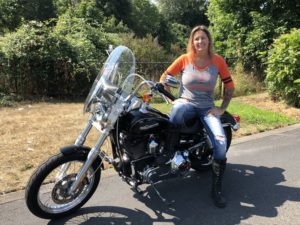Beating the odds
October 2017‘s mystery location: Mukilteo, Washington
Bruce Carman of Gig Harbor, Washington, recognized the mystery location of Mukilteo, Washington, when he read the clues early in October. His wife Diana, who Carman met through Diana’s sister in 1980, once lived in Mukilteo. Bruce and Diana married in 1980 and their daughters, ages 35 and 30, are high school teachers in Bremerton. A son, age 25, is enrolled at Olympic College. Diana, 56, works as a nuclear engineer at the Puget Sound Naval Shipyard in Bremerton. The couple are in the process of divorcing after 37 years together.
Born in California, Bruce’s family moved to Oregon in his junior year in high school. Given his stepfather was in the U.S. Navy, where the elder was sent, the family would follow. When Guam was a planned post, Bruce Carman opted for Coos Bay, Oregon, and Uncle Monte Moran’s instead. “I couldn’t see graduating from Guam high school.”
Uncle Monte introduced his nephew to motorcycling, even taking the lad along on the 1965 AMA Gypsy Tour. Monte was a member of the Trade Winds Motorcycle Club and a significant mentor for Carman.
When Bruce Carman drew #9 in the military draft just out of high school, he served four years as an electrician on Navy submarines. Afterward (’77–’83) he moved to Port Gamble, Washington, and worked several positions in a sawmill there. From ’83–’90 Carman worked, again as an electrician, at Puget Sound Naval Shipyard in Bremerton. That work was in proximity to some hazardous materials, asbestos among them. “We’d go in where insulation was being removed from ships built in the ’40s and ’50s,” he said; often those particulates were airborne. It would be decades until he thought about the exposures.
From 1990–’93 Carman owned and operated a Coast to Coast hardware store in Condon, Oregon. He enjoyed the great outdoors of the Pacific Northwest, including deer hunting in the fall. Returning to Washington State, an electrician job at Boeing was fruitful from ’96 until the layoffs of 2003. He took a two-year college program offered—an auto tech class at Olympic College. He bought a project rig for that effort, a 1977 Ford Bronco (pictured). He returned to Boeing when things rebounded and finally retired in 2009. There was a wee bit of a hiccup in his tenure there from 2006–’08, but more about that in a moment.
Uncle Monte, who died earlier this year, provided the spark that would find Carman a lifelong rider, beginning in high school. His first ride was a 100 Yamaha, then while in the Navy a 500 Kawasaki, then a 650 BSA. Later, a 1000 Sportster he had for 20 years, a 1200 Sportster acquired in 2001 and in 2012, a five-year-old Street Glide with only 3,000 miles on it. “It had the quick-disconnect tour trunk, the Garmin, all things I might put on myself.” He took the bike to Rich’s Custom Seats in Kingston, Washington, for a rebuild and was pleased enough to ride to Meridian, Idaho, for the H.O.G. Rally this year.
While hunting in Pullman, Washington, late in ’98 Carman noticed he was out of breath, not just winded but breathing heavily. Accustomed to outdoor exercise without such a compromise, it was worrisome. Two years and two clinicians later, with biopsy tissue plucked from him, in 2000 he was diagnosed with pulmonary fibrosis. Unable to determine the root cause, physicians labeled it “idiopathic,” which Carman explained “is doctor talk for eehhh.” On the advice of Doctor Mulligan from the University of Washington and after months of testing to see if he was a good candidate, in 2006 Bruce Carman got on a donor list for new lungs. The average wait time, he was told, was 2 1/2 years. He was given a beeper and orders to stay within two to three hours’ proximity of Seattle at all times. Eleven days later the beeper summoned him to the UW. “I never had time to get nervous,” he said. The surgery was conducted in 2006 and Bruce returned to work in 2008, taking early retirement from Boeing in 2009.
Patients of this procedure, a double lung transplant, are told at the onset that they should anticipate a life expectancy of three years. Oftentimes the reason for so slight a prediction is because while awaiting the transplant it’s an enormous strain on the heart. “It’s a muscle, and when overused it becomes enlarged,” explained Carman. It’s been 11 years since the surgery and today Bruce Carman admits his great good fortune in beating those odds and credits deer hunting with bringing the problem to the surface.
“Now,” he says, given the success of his procedure, and how long he’s lived beyond the original estimate, “I’m the poster boy for the UW Medical Center.”















